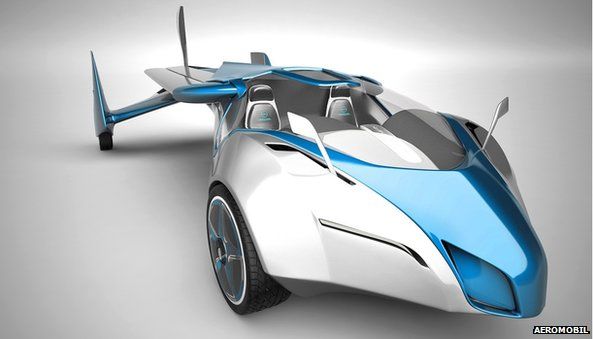Flying car technology is turning a dream into reality
- Published

In 1940 Henry Ford famously said: "Mark my word: A combination airplane and motorcar is coming. You may smile, but it will come."
Just nine years later Moulton Taylor had designed and flown his Aerocar, proving the viability of Ford's fantastical concept.
But only three models were ever built, and the dream of a viable vehicle that can offer freedom both in the air and on the road has remained frustratingly elusive.
Until now that is.
Technology - "sense and avoid" avionics, computer-aided design, and materials science - has advanced to such a degree that safety authorities are tantalisingly close to giving full approval to flying cars.
"Since the Wright Brothers and Henry Ford we've had the dream of marrying the plane and the car," said Dick Knapinski, spokesman for the US Experimental Aircraft Association, "but engineering, regulatory and cultural hurdles have always got in the way.
"Now we are really getting closer to making the dream come true."
Experimental
For example, in July this year, Boston-based company Terrafugia showed off its Transition "roadable aircraft" at the Experimental Aircraft Association (EAA) AirVenture event in Oshkosh, Wisconsin.
"We have an experimental airworthiness certificate from the FAA [US Federal Aviation Authority] which means we still have to stay away from populated areas," said Richard Gersh, Terrafugia's vice-president of business development, "but everything is going to plan to achieve full certification."
The Transition, whose wings fold up against the body of the carriage, is also licensed for testing on the road, but Mr Gersh emphasises its primary function is as an aircraft.
"We don't envisage this replacing your family car, and you'll always have to take off and land at an airport," he said. "But it does give you the flexibility of driving to the airport and to your destination at the other end."
When the Transition eventually goes on sale - which could be in two years, depending on how long full safety certification takes - it will retail for about $280,000 (£173,000), slightly cheaper than a Cessna Skyhawk fixed-wing plane.
The company has already received more than 100 orders, said Mr Gersh.
Les Dorr, FAA spokesman, told the BBC: "If a 'flying car' is intended to operate on US highways then the vehicle has to conform to both the applicable US Department of Transportation standards for a car and the applicable aviation standards for an aircraft.
"Terrafugia is the only US aircraft certification project that has obtained an exemption or for which we've defined the certification requirements with both the FAA and NHTSA [National Highway Traffic Safety Administration]."
Vertical take-off
Looking to the future, Terrafugia's concept craft - the TF-X - will incorporate vertical take-off and landing thanks to hinged propellers on the foldable wings combined with a rear propeller for forward propulsion.
It will be a plug-in hybrid electric flying car promising a top speed of 200mph (320km/h) and a range of about 500 miles.
The company envisages incorporating existing autopilot and new sense-and-avoid technology to help it steer clear of air traffic, bad weather and restricted airspace.
It will also include a full parachute system in case of total engine failure, and an auto-land capability if the pilot becomes incapacitated.
But Mr Gersh estimates that the TF-X is "about eight to 10 years away" from becoming a reality.
Another US outfit, the Indigenous Peoples' Technology and Education Center (I-TEC), has developed the Maverick LSA, a rough terrain buggy that can fly using a rear propeller and parachute combination.
Built by Beyond Roads, it is designed to aid humanitarian missions to difficult-to-reach areas.
The parachute is hoisted up a flexible mast to prevent it fouling the rear propeller.
At the moment, the vehicle is treated as a "kit car" for regulatory purposes and also has a Special Light Sport Aircraft airworthiness certificate.
Film inspiration
Stefan Klein, co-founder and chief designer at Slovakian firm Aeromobil, caught the flying car bug as a child after watching the French filmFantomas se Dechaine, featuring a Citroen DS that could turn into a rocket-powered plane.
A graduate of the Slovak University of Technology and a former head of research projects for Audi, Volkswagen and BMW at the Academy of Fine Arts and Design, he comes from a family of aviators and has spent about 20 years trying to make his dream come true.
The svelte-looking "pre-prototype" 2.5, which made its debut flight in Montreal in September this year, is potentially the shape of things to come.
With hinged wings that sweep forward for flight, a top air speed of more than 200km/h (124mph) and flight range of 700km (430 miles), the Aeromobil certainly looks like a credible player in the nascent flying car market.
But spokeswoman Tatiana Veberova admits: "We haven't even begun to solve the problem of certification yet. We have a long way to go."
The 3.0 prototype is likely to be ready in 2014, she said, and the company intends to target the US market where regulatory acceptance is more advanced than in Europe.
So technology is finally making flying cars a viable product for the mass market, and regulators are certainly catching up with the speed of development.
But are we really ready for motorways in the sky?
"Lots of people are still afraid of flying," says Mr Knapinksi at the EAA. "There's a mystery about it. That's also part of its joy.
"Gaining cultural acceptance for flying cars will be the last hurdle to overcome."
- Published11 April 2012
- Published12 January 2009